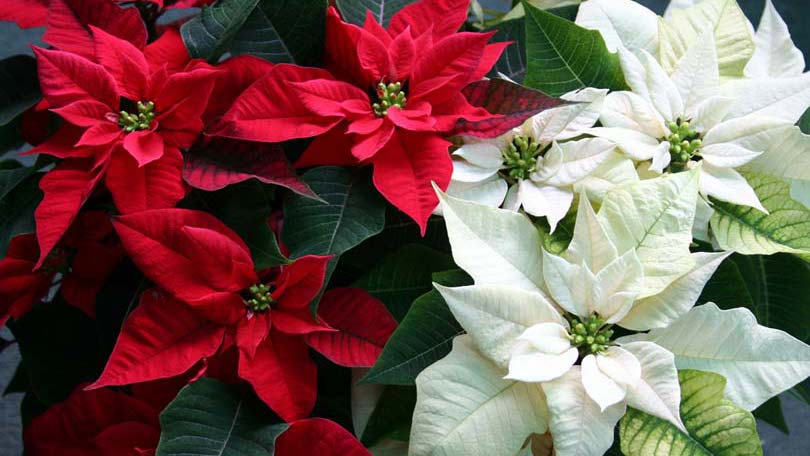
When the Christmas season starts setting in, you will find many houses having a common plant adorning their interiors. The vividly colored poinsettia. Although it looks very colorful, it isn’t a flowering plant. Since it looks pretty and can make the interiors very vibrant, instead of spending on pricey flower plants, many people decorate their homes with poinsettias.
Background of the Poinsettia
The poinsettia is basically a native plant of Mexico, where it grows wild. Joel Robert Poinsett, the amateur botanist and first ambassador to Mexico, first introduced it in the US in 1825. The story goes that he brought some cuttings to his Greenwood plantation, in South Carolina. Ever since, this plant has become a household name all over the country.
There have been a few stories attached to this plant. According to a legend, a small girl called Pepita did not have a gift to present baby Jesus, so she collected a handful of weeds on her way to church. As she neared the church, she noticed that the weeds had bloomed miraculously into vibrantly colored flowers, which came to be known as Flowers of the Holy Night or Flores de Noche Buena.
The various names of the Poinsettia
The Aztec name for the plant was Cuetlaxochitl. They made a reddish purple dye from the bracts. The poinsettia is known as the Crown of the Andes in Chile and Peru. The plant is also referred to as the Flame Leaf Flower. It is a perennial flowering shrub that can grow up to ten feet in height.
The Poinsettia – Botanically speaking
Poinsettia (Euphorbia pulcherrima) is also called Mexican Flame Leaf. It is an open, partially deciduous shrub, erect and spreading, and generally sparingly branched. The leaves are lobed or toothed, and are ovate to lance-shaped. These are medium to deep green in color, and 15 cm long.
The colors of the Poinsettia range from white to pink, to the traditional red. There are other color variants, like shades of yellow and peach, in between. The new varieties come in marbled, wrinkled and even flecked bracts. Grown from tiny plantings, they are grown in all fifty states, although most originate from the Paul Ecke Ranch in California.
Is the Poinsettia poisonous?
It is a mistaken notion held by many that the poinsettia is a poisonous plant. But, according to scientific tests conducted by the Ohio State University, the plant is non-toxic to both humans and animals. As a matter of fact, according to studies conducted by the Carnegie Mellon University and Children’s Hospital in Pittsburgh, out of the 22,793 reported exposures, there was no significant toxicity found. Hence, even pet owners need not ban the poinsettia. However, to avoid it being accidentally eaten, it is advisable to keep the plant out of reach of small children and pets. Like all ornamental plants, the poinsettia is not edible, and can certainly cause discomfort if ingested.
Price of a Poinsettia
Poinsettias are priced from under $10 to more than $100, based on the variety, size, shape, decorative trim and quality. When buying a poinsettia, make sure the bracts are thoroughly colored and expanded, the stems are sturdy, there are no signs of wilting, and it has plentiful green foliage.
Care
Poinsettias need indirect sunlight, room temperature, and light to average soil moisture. Excessive temperatures and over watering are the most common threats to the plant. Simply prevent soggy soil, excessive heat, or cold drafts, for a healthy plant. Thus, with a little care, your poinsettias can last through Christmas and even after that. These beautiful make popular gifts, and are a favorite decorative item.
How to take care of the Poinsettia in different seasons
In the winter, the poinsettia bears terminal cymes, about 30 cm across, and green colored cyathia encircled by leaf-like, large bright red bracts. Some varieties have white or cream involucra. Although these bright red bracts are usually mistaken for flowers, in fact they are the small yellow buds in the center.
You can grow Poinsettias in the spring by sowing seeds, or in the early spring by division, or use basal cuttings either in early summer or spring. To prevent bleeding, you can dip the cut surfaces in charcoal or lukewarm water.
Poinsettias need a soil mix of 3 parts loam-based potting compost and one part grit. It likes a well-ventilated position and full light. When in growth, water it sparingly and fertilize it with a low-nitrogen liquid fertilizer every month. Keep it dry during winter.
Poinsettias are short-day plants and need extra care to have them bloom for Christmas. Put the plants in a place where night temperatures are around 15 degrees Celsius (60 F), and keep them away from artificial light at night.
To initiate flowering, poinsettias need 12-14 hours of complete darkness daily for a minimum of two months. You can control the day length by putting the plant in a dark area at around 5 pm and removing it at 8 am. This needs to be done for 11 weeks. Start in mid autumn for a good bloom in Christmas. Plus, make sure to water them adequately, control night temperatures, and fertilize them to get a healthy color display for the holidays.
After the plant flowers, to get the brightest bract color, make sure to keep the compost moist and place it in a brightly lit room. The plants tend to lose color and start shedding leaves and bracts if they get very cold. Therefore, make sure they are well covered when you buy them in the flowering season.

